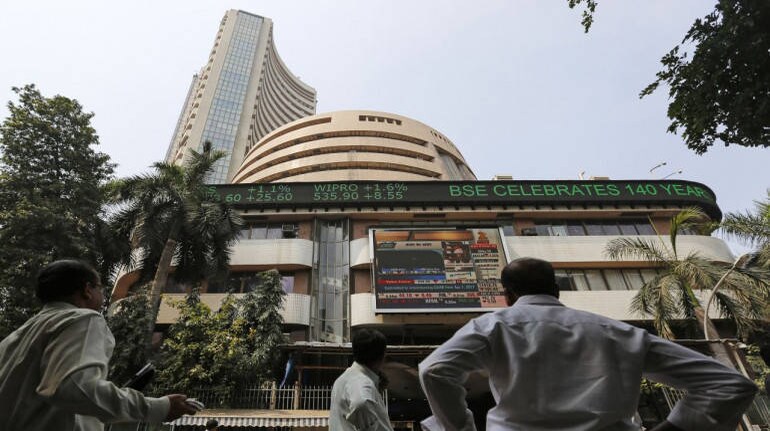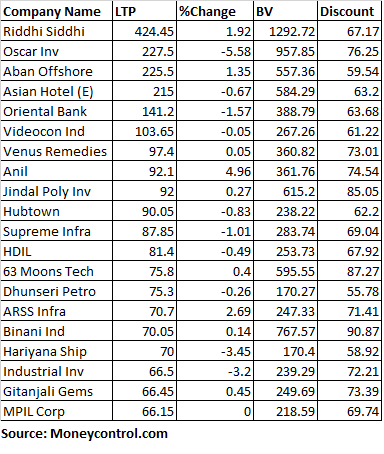



Investors are always looking for stocks which are undervalued and price below book value is a good measure to track companies which might be worth looking at.
Let’s first understand what is the book value of a stock. Book value should ideally include everything has such as stocks, bonds, inventory, machinery, real estate etc. Companies with lots of machinery would have large book values. It is used as a number 1 figure while evaluating such companies.
A simple way is to just divide the current value of the stock by its stated book value per share, which will give us price-to-book value. If the ratio is less than 1 means that if the company goes bankrupt, it has enough means to pay off debtors and pay off shareholders.
“The book value of a company is the tangible net worth which should be available to the shareholders assuming current wind up of the company at book value. In other words, it is the amount of money invested by shareholders including the retained profits,” Vinod Nair, Head of Research at Geojit Financial Services told moneycontrol.
“P/BV ratio also provides a much simpler benchmark for relative analysis because companies in similar industries follow consistent accounting standards. Price-to-book value can be effectively used for companies under negative earnings or when the earnings are low which cannot be valued on a price-to-earnings ratio basis,” he said.
Stocks which are trading at discount to BV
Stocks, which are trading at discount to book value, include names like Aban Offshore, Oriental Bank of Commerce, Videocon Industries, Venus Remedies, HDIL, 63 Moons Technologies, Jindal Poly, ARSS Infra, Gitanjali Gems, Binani Industries, among others.
Binani Industries is trading at a steep discount of over 90 percent from its book value, followed by 63 Moons, which was trading 87 percent lower and Jindal Poly was trading 85 percent discount over its book value.

What should investors do?
Well, at the time of bull market, if stocks are trading at steep discounts to their book value then it needs further investigation. Usually, this ratio is more useful in bear markets.
Not every stock is a buy and investors should use other parameters to come to a qualitative judgement about the investment decision. Investors should have some part of the portfolio in these stocks as they come with low risk.
“Investing in stocks available below book value falls under realms of value investing. However, such style of investing is more appropriate during bear markets,” said Jimeet Modi, CEO, SAMCO Securities told moneycontrol.
But, during bull markets, growth investing gives more stock appreciations then value investing, but nonetheless, growth investing has higher risks too.
“The strategy to play out at current juncture of the bull market would be to accumulate value investing portfolio by allocating 20 percent of the capital containing all the profit making stocks below book value generating ROE of 10 percent and above,” he said.
This entire portfolio would deliver returns in line with the market returns but with much lower risks. Some stocks may outperform but some may languish. However, at an aggregate level, the returns will be net positive, suggest experts.
Where is price-to-book (P/BV) is used more often?
Price to book value measure is used for those companies whose present value of the assets cannot be truly reflected in the book value. For banks’ valuation, P/BV is most suited given its borrowing business model and narrow RoE structure.
P/BV cannot be used effectively for companies where the current book value does not factor the true current market price of assets given the difference in historical cost accounting and future value.
What are the other parameters to be used along with P/BV?
Book value should not be seen in isolation. It is recorded at original cost and earning power of the asset is not taken into account. It differs from the market value as the market price factors future prospects.
Nair is of the view that companies with a lot of fixed assets say manufacturing companies have a high book value and investors should consideration other parameters which are related to its earnings growth, industry outlook, and cyclicality.
Modi of Samco Securities recommends investors to look at the debt equity ratio of a company which should be less than 1, with a track record of PAT growth of 10 percent and above and ROE above 12 percent would be sufficient to filter out stocks.
Discover the latest Business News, Sensex, and Nifty updates. Obtain Personal Finance insights, tax queries, and expert opinions on Moneycontrol or download the Moneycontrol App to stay updated!
Find the best of Al News in one place, specially curated for you every weekend.
Stay on top of the latest tech trends and biggest startup news.